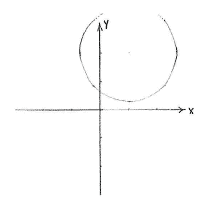Solution 4.1:6b
From Förberedande kurs i matematik 1
(Difference between revisions)
m (Lösning 4.1:6b moved to Solution 4.1:6b: Robot: moved page) |
|||
| Line 1: | Line 1: | ||
| + | A quick way to interpret the equation is to compare it with the standard formula for the equation of a circle with centre at | ||
| + | <math>\left( a \right.,\left. b \right)</math> | ||
| + | and radius | ||
| + | <math>r</math>, | ||
| + | |||
| + | |||
| + | <math>\left( x-a \right)^{2}+\left( y-b \right)^{2}=r^{2}</math> | ||
| + | |||
| + | |||
| + | In our case, we can write the equation as | ||
| + | |||
| + | |||
| + | <math>\left( x-1 \right)^{2}+\left( y-2 \right)^{2}=\left( \sqrt{3} \right)^{2}</math> | ||
| + | |||
| + | |||
| + | and then we see that it describes a circle with centre at | ||
| + | <math>\left( 1 \right.,\left. 2 \right)</math> | ||
| + | and radius | ||
| + | |||
| + | |||
{{NAVCONTENT_START}} | {{NAVCONTENT_START}} | ||
[[Image:4_1_6_b.gif|center]] | [[Image:4_1_6_b.gif|center]] | ||
| - | <center> [[Image:4_1_6b.gif]] </center> | ||
{{NAVCONTENT_STOP}} | {{NAVCONTENT_STOP}} | ||
Revision as of 11:33, 27 September 2008
A quick way to interpret the equation is to compare it with the standard formula for the equation of a circle with centre at \displaystyle \left( a \right.,\left. b \right) and radius \displaystyle r,
\displaystyle \left( x-a \right)^{2}+\left( y-b \right)^{2}=r^{2}
In our case, we can write the equation as
\displaystyle \left( x-1 \right)^{2}+\left( y-2 \right)^{2}=\left( \sqrt{3} \right)^{2}
and then we see that it describes a circle with centre at
\displaystyle \left( 1 \right.,\left. 2 \right)
and radius

